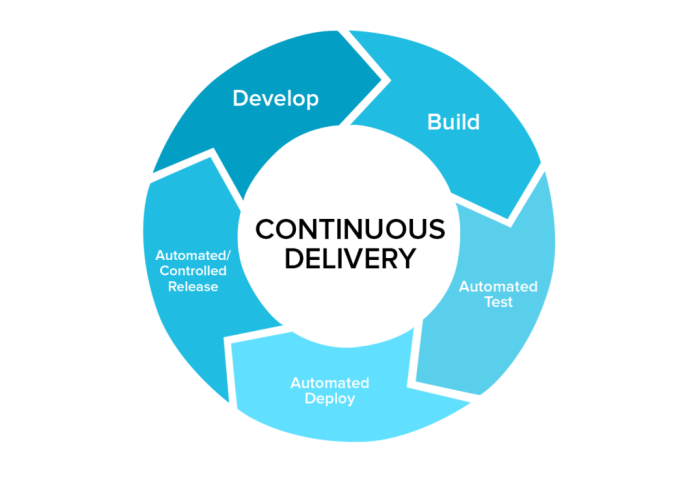
Continuous delivery best practices in agile projects set the stage for efficient software development processes. From continuous integration to automation tools, this overview delves into key strategies for project success.
Exploring quality assurance, collaboration, and microservices architecture, this guide offers valuable insights for enhancing project outcomes.
Continuous Delivery Best Practices in Agile Projects
Continuous delivery in agile projects refers to the practice of automating the software delivery process to ensure that code changes are always ready for deployment. This allows development teams to deliver new features, fixes, and updates to customers quickly and efficiently.One key component of continuous delivery is continuous integration, which involves merging code changes into a shared repository multiple times a day.
This helps identify and address integration issues early on, ensuring that the software remains in a deployable state at all times.
Tools for Automating Continuous Delivery
- Jenkins: An open-source automation server that enables the continuous integration and delivery of software.
- GitLab CI/CD: Provides a complete DevOps platform with built-in continuous integration and continuous delivery capabilities.
- CircleCI: A cloud-based platform that automates the build, test, and deployment process.
Benefits of Implementing Continuous Delivery Practices
- Reduced Time-to-Market: Continuous delivery allows for faster delivery of features and updates, enabling businesses to respond to market demands more quickly.
- Improved Product Quality: By automating the testing and deployment process, continuous delivery helps identify and fix issues early on, leading to higher-quality software.
- Enhanced Collaboration: Continuous delivery encourages collaboration between development, operations, and other teams, leading to smoother and more efficient delivery processes.
Ensuring Quality in Continuous Delivery

Ensuring quality in continuous delivery is crucial for the success of agile projects. By implementing effective strategies and incorporating automated testing, code reviews, and monitoring practices, teams can maintain high-quality code throughout the delivery pipeline.
Strategies for Ensuring Quality Control
- Implement automated testing at different stages of the pipeline to catch bugs early and ensure code quality.
- Utilize continuous integration to run tests automatically whenever new code is added to the repository.
- Leverage tools for code analysis and static code review to identify potential issues and improve code quality.
Role of Automated Testing
Automated testing plays a crucial role in maintaining high-quality code in continuous delivery by enabling teams to detect defects early in the development process. By automating tests for functionality, performance, and security, teams can ensure that the code meets the required quality standards before being deployed.
Incorporating Code Reviews and Automated Checks
- Conduct regular code reviews to identify and eliminate defects, improve code readability, and ensure adherence to coding standards.
- Integrate automated checks into the pipeline to enforce coding guidelines, detect vulnerabilities, and prevent defects from reaching production.
- Utilize static code analysis tools to identify potential issues and maintain code quality throughout the development cycle.
Best Practices for Monitoring and Measuring Quality
- Implement monitoring tools to track the performance and stability of software releases in real-time.
- Use key performance indicators (KPIs) to measure the quality of releases and identify areas for improvement.
- Establish a feedback loop with stakeholders to gather insights on the quality of software releases and make necessary adjustments.
Collaboration and Communication in Continuous Delivery

Collaboration and communication are essential components of successful continuous delivery in agile projects. By fostering a culture of open communication and collaboration between development, operations, and testing teams, organizations can ensure seamless delivery of high-quality software products.
Importance of Collaboration
Effective collaboration between development, operations, and testing teams is crucial in continuous delivery. It helps in breaking down silos, promoting shared goals, and ensuring that everyone is aligned towards the same objectives. By working together, teams can identify issues early, streamline processes, and deliver value to customers faster.
- Encouraging regular cross-team meetings to discuss progress, challenges, and dependencies.
- Implementing tools for real-time collaboration and sharing of information.
- Promoting a culture of respect and trust among team members to encourage open communication.
Communication Strategies
Transparency and alignment across teams can be achieved through effective communication strategies. By utilizing tools like chat platforms, project management tools, and regular status updates, teams can ensure that everyone is on the same page and working towards common goals.
- Establishing clear communication channels and protocols for sharing updates and information.
- Encouraging feedback and suggestions from all team members to foster a culture of continuous improvement.
- Conducting regular retrospectives to reflect on communication processes and make necessary adjustments.
Cross-Functional Teams in Continuous Delivery
Cross-functional teams play a significant role in successful continuous delivery by bringing together individuals with diverse skills and expertise. These teams are able to address complex challenges, make informed decisions, and deliver high-quality software products efficiently.
- Assigning tasks based on expertise rather than job titles to promote collaboration and knowledge sharing.
- Encouraging team members to take ownership of their work and collaborate across disciplines.
- Empowering teams to make autonomous decisions and adapt quickly to changes in requirements.
Successful Communication Practices, Continuous delivery best practices in agile projects
Examples of successful communication practices in agile projects implementing continuous delivery include:
- Using visual management tools like Kanban boards to track progress and dependencies.
- Conducting daily stand-up meetings to discuss achievements, challenges, and plans for the day.
- Implementing continuous integration and automated testing to ensure fast feedback and early identification of issues.
Microservices Architecture in Software Engineering
Microservices architecture is an approach to software development where a complex application is broken down into smaller, independent services that are loosely coupled and can be deployed independently. This architecture allows for greater flexibility, scalability, and resilience in software systems.
Differences between Monolithic and Microservices Architectures
Monolithic architecture involves building a single, large application where all components are tightly integrated. On the other hand, microservices architecture breaks down the application into smaller, independent services that communicate through APIs. Here are some key differences:
- Scalability:Monolithic applications scale by replicating the entire application, while microservices can scale specific services independently.
- Flexibility:Monolithic applications are harder to update and maintain, while microservices allow for easier updates and deployments.
- Resilience:Monolithic applications are more prone to failure, as a single error can bring down the entire system. Microservices are more resilient as failures are isolated to specific services.
Companies Implementing Microservices Architecture
Several companies have successfully implemented microservices architecture to improve their software systems. Some notable examples include:
- Netflix:Netflix uses microservices to handle their massive streaming platform, allowing them to scale different components independently.
- Amazon:Amazon’s e-commerce platform is built using microservices, enabling them to quickly add new features and scale their system as needed.
- Uber:Uber utilizes microservices to power their ride-sharing app, ensuring high availability and reliability for millions of users.
Benefits of Microservices Architecture
Microservices architecture contributes to scalability, flexibility, and resilience in software systems in the following ways:
- Allows for independent scaling of services based on demand.
- Enables faster development and deployment of new features.
- Improves fault isolation, preventing system-wide failures.
- Facilitates easier maintenance and updates without affecting the entire system.
Last Word
In conclusion, mastering continuous delivery best practices in agile projects is essential for achieving seamless software deployment. By prioritizing quality, communication, and innovative architecture, teams can elevate their project performance to new heights.
FAQ Insights: Continuous Delivery Best Practices In Agile Projects
What is the role of automated testing in continuous delivery?
Automated testing plays a crucial role in maintaining high-quality code throughout the continuous delivery pipeline. It helps identify issues early on and ensures smoother deployments.
How can collaboration enhance continuous delivery practices?
Collaboration fosters transparency and alignment between development, operations, and testing teams, leading to more efficient and successful continuous delivery implementations.
What are the benefits of microservices architecture in software development?
Microservices architecture offers scalability, flexibility, and resilience in software systems by breaking down applications into smaller, manageable components that can be independently deployed and maintained.






